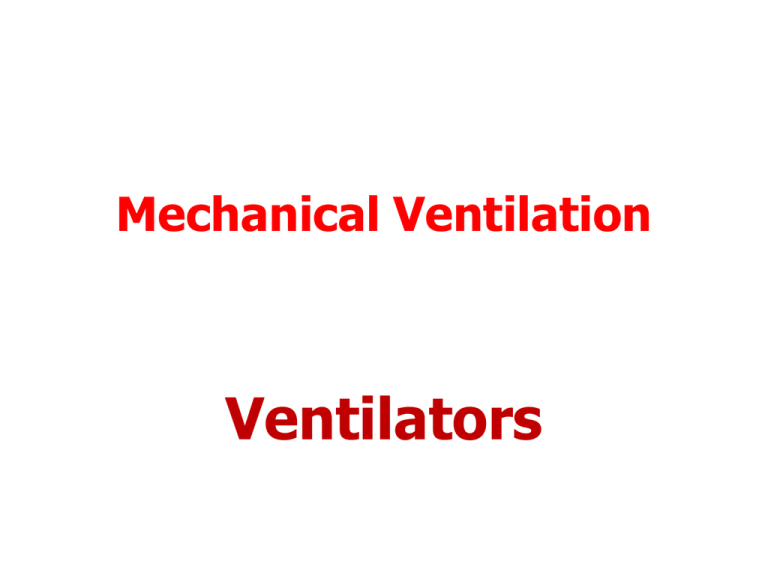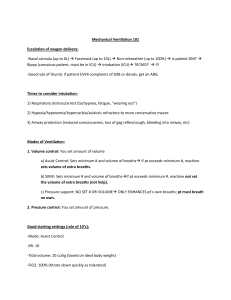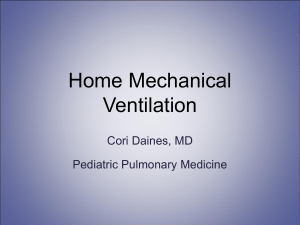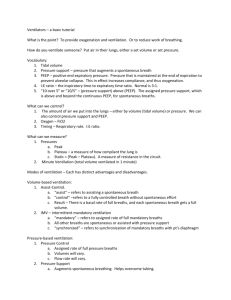respiratory 12
advertisement

Mechanical Ventilation Ventilators Origins of mechanical ventilation • Negative-pressure ventilators (“iron lungs”) • Non-invasive ventilation first used in Boston Children’s Hospital in 1928 • Used extensively during polio outbreaks in 1940s – 1950s • Positive-pressure ventilators • Invasive ventilation first used at Massachusetts General Hospital in 1955 • Now the modern standard of mechanical ventilation Negative pressure Negative pressure ventilator • The person using the iron lung is placed into the central chamber, a cylindrical steel drum. • A door allowing the head and neck to remain free is then closed, forming a sealed, airtight compartment enclosing the rest of the person's body. • Pumps that control airflow periodically decrease and increase the air pressure within the chamber, and particularly, on the chest. • When the pressure is below that within the lungs, the lungs expand and atmospheric pressure pushes air from outside the chamber in via the person's nose and airways to keep the lungs filled; • when the pressure goes above that within the lungs, the reverse occurs, and air is expelled. In this manner, the iron lung mimics the physiological action of breathing: by periodically altering intrathoracic pressure, it causes air to flow in and out of the lungs. The iron lung is a form of non-invasive therapy. Types of Ventilators (Positive) • Pressure-cycled modes 1) Pressure Support Ventilation (PSV) 2) CPAP (Continuous positive airway pressure) 3) BiPAP (Bi-level positive airway pressure) • Volume-cycled modes 1) Control mode 2) Assist mode 3) Assist/Control mode 4) Intermittent Mandatory Ventilation (IMV) 5) Synchronous Intermittent Mandatory Ventilation (SIMV) CPAP • Continuous positive airway pressure (CPAP) is the use of continuous positive pressure to maintain a continuous level of positive airway pressure. • A continuous level of elevated pressure is provided through the patient circuit to maintain adequate oxygenation, decrease the work of breathing, and decrease the work of the heart (such as in left-sided heart failure CHF) BiPAP BiPAP It delivers a preset inspiratory positive airway pressure (IPAP) and expiratory positive airway pressure (EPAP). Use Bi-level positive airway pressure is used when positive airway pressure is needed with the addition of pressure support. Common situations where positive airway pressure is indicated is any disease where taking a breath is difficult. This includes pneumonia, chronic obstructive pulmonary disease and asthma . Assist/Control Mode – Volume Cycled modes • Control Mode • Patient receives a set number of breaths and cannot breathe between ventilator breaths • Assist Mode • Patient initiates all breaths, but ventilator cycles in at initiation to give a preset tidal volume • Patient controls rate but always receives a full machine breath • Assist/Control Mode • Assist mode unless patient’s respiratory rate falls below preset value. • Ventilator then switches to control mode IMV and SIMV • Intermittent Mandatory Ventilation (IMV) • Pt receives a set number of ventilator breaths • Patient can initiate own (spontaneous) breaths • spontaneous breaths are not supported by machine with fixed TV • Ventilator always delivers breath, even if pt exhaling • Synchronous Intermittent Mandatory Ventilation (SIMV) • Most commonly used mode • Spontaneous breaths and mandatory breaths • If pt has respiratory drive, the mandatory breaths are synchronized with the pt’s inspiratory effort Indications for intubation • Criteria • Clinical deterioration • Tachypnea: RR >35 • Hypoxia: PaO2<60mm Hg • Hypercapnea: PaCO2 > 55mm Hg • Minute voluntary ventilation( MVV)<10 L/min • Tidal volume(TV) <5-10 ml/kg • Negative inspiratory force < 25cm H2O (how strong the pt can suck in) Initial ventilatory settings • Fractional inspired oxygen concentration (FiO2 ) = 50% • Positive end expiratory pressure (PEEP) = 5cm H2O • Respiratory rate (RR) = 12 – 15 breaths/min • Tidal volume (VT ) = 10 – 12 ml/kg • Pressure Support = 10 cm H2O Indications for extubation • Clinical parameters • Resolution/Stabilization of disease process • Hemodynamically stable • Intact cough/gag reflex • Spontaneous respirations • Acceptable vent settings • FiO2< 50%, PEEP < 8, PaO2 > 75mm Hg, PH > 7.25 Weaning • General approaches • SIMV Weaning • Pressure Support Ventilation (PSV) Weaning • Spontaneous breathing trials




